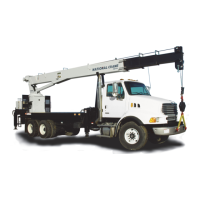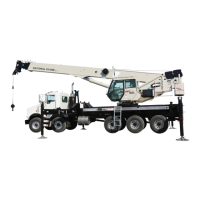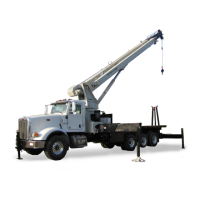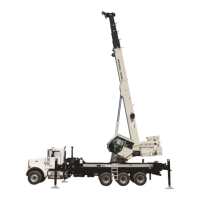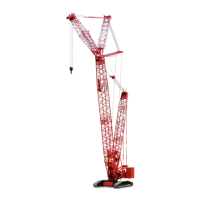National Crane PUBLISHED 04-26-2019 CONTROL # 113-09 2-29
600E2 OPERATOR MANUAL SAFETY PRECAUTIONS
• If equipped, disconnect battery with the battery
disconnect switch before disconnecting the ground
battery cable.
• Do not break a live circuit at the battery terminal.
Disconnect the ground battery cable first when removing
a battery and connect it last when installing a battery.
• Do not short across the battery posts to check charge.
Short circuit, spark, or flame could cause battery
explosion.
• Maintain battery electrolyte at the proper level. Check
the electrolyte with a flashlight.
• If applicable to your equipment, check battery test
indicator on maintenance-free batteries.
• Check battery condition only with proper test equipment.
Batteries shall not be charged except in an open, well-
ventilated area that is free of flame, smoking, sparks,
and fire.
Engine
Fuel the equipment only with the engine turned off. Do not
smoke while fueling the equipment. Do not store flammable
materials on the equipment.
Be familiar with the location and use of the nearest fire
extinguisher.
Be careful when checking the engine coolant level. The fluid
may be hot and under pressure. Shut down the engine and
allow the radiator time to cool before removing the radiator
cap.
Shut down the engine and disconnect the battery before
performing maintenance. If unable to do so for the task
required, keep hands clear of the engine fan and other
moving parts while performing maintenance.
Be careful of hot surfaces and hot fluids when performing
maintenance on or around the engine.
Do not use ether to start the engine on equipment equipped
with intake manifold grid heaters.
TRANSPORTING THE EQUIPMENT
Before transporting the equipment, check the suitability of
the proposed route with regard to the equipment height,
width, length, and weight.
Check load limits of bridges on the travel route and ensure
they are greater than the combined weight of the equipment
and transporting vehicle.
When loading or unloading the equipment on a trailer or
railroad car, use a ramp capable of supporting the weight of
the equipment.
Ensure the equipment is adequately secured to the
transporting vehicle.
Do not use the dead end lug on the boom nose for tying
down the boom during transport. Damage to the lug and
boom can result from usage as a tie down point.
Before transporting the equipment on a road or highway, first
check state and local restrictions and regulations.
Either the hook block may be reeved over the main boom
nose or the headache ball may be reeved over the main
boom nose or auxiliary boom nose; the other must be
removed. If the hook block or headache ball remains reeved
on the boom, it must be secured at the tie down on the carrier
to prevent swinging.
When using hookblock tie downs, excessive loading can be
applied by pulling the cable too tight, particularly when
reeved with multiple part lines. When the cable is hooked
into the hookblock tie down, the cable should be merely
“snugged-up” with adequate slack provided at the center line
of sheave to anchor point and avoid contact with surrounding
components. Do not draw cable taut. Care must be
exercised anytime any equipment function is being
performed while the cable is hooked into the hookblock tie
down.
TRAVEL OPERATION
Only the equipment operator shall occupy the equipment
when traveling.
When traveling, the boom should be completely retracted
and lowered to the travel position. If equipped with boom
rest, lower the boom into the boom rest and engage the
turntable swing lock pin and/or 360 degree swing lock.
Strictly adhere to the guidelines and restrictions in the Load
Chart for operations.
Traveling at high speeds, especially on rough ground, may
create a bouncing effect that can result in loss of control. If
bouncing occurs, reduce travel speed.
Stunt driving and horse-play are strictly prohibited. Never
allow anyone to hitch a ride or get on or off moving
equipment.
Follow the instructions in this manual when preparing the
equipment for travel.
If using a boom dolly/trailer, thoroughly read and understand
all the steps and safety precautions in this manual for setup
and travel.
When driving the equipment, ensure the cab is level, if
equipped with a tilting cab.
Secure the hook block and other items before moving the
equipment.
Watch clearances when traveling. Do not take a chance of
running into overhead or side obstructions.
Fo
r
Reference
Only

